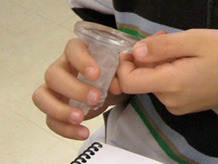What can we learn about minerals by observing them carefully?
1. Ask the question

Return to the piece of quartz and piece of granite from the previous investigation.
What did you discover about quartz and granite in the last investigation?
Might the granite be made of other kinds of minerals as well as quartz?
Explain that today's investigation will focus on minerals, the natural materials that often appear in rocks. There are thousand of different minerals in the Earth. While most of these minerals are mixed together to form the different types of rocks, sometimes they are found unmixed, like the piece of quartz. Today, students will explore just a few of the common minerals, separately ... somewhat like exploring the separate ingredients for cookies before they are mixed together and baked — the sugar, the chocolate, the flour and butter.
Students may be intrigued to learn that people have found many different ways to make use of Earth's minerals. For example:
- Quartz is used as sandpaper.
- Graphite is used in pencil lead.
- Salt or halite is used on food.
- Talc is used as a powder for babies.
- Mica is often used in toothpaste.
Draw attention to the investigation question:
What can we learn about minerals by observing them carefully?
This is the same question students explored in the last class, except that instead of observing rocks, this time the class will be observing minerals. Engage the class in imagining how this investigation will go.
- Can we use the same techniques to observe minerals that we used to observe rocks?
- Do minerals have the same properties as rocks?
As you listen to the students’ responses, remind them to keep track of their ideas and questions in their science notebooks.



